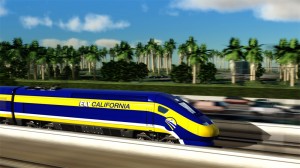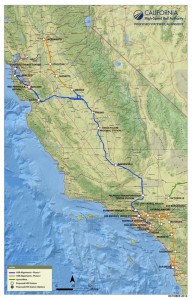What’s The Future Of California’s High Speed Rail System?
Join My KALW Radio Conversation Tonight With Authority Chair Dan Richard At 7pm
 California’s high speed rail system has been moving at a low speed since voters approved a bond issue to launch it in 2008. That ballot measure authorized a bullet train from San Francisco to Los Angeles and eventually Anaheim, at speeds of 220 miles per hour and stops in Central Valley cities like Fresno and Bakersfield. The total trip time would be no more than 2 hours and 40 minutes between the two big cities, at fares less than airplane travel.
California’s high speed rail system has been moving at a low speed since voters approved a bond issue to launch it in 2008. That ballot measure authorized a bullet train from San Francisco to Los Angeles and eventually Anaheim, at speeds of 220 miles per hour and stops in Central Valley cities like Fresno and Bakersfield. The total trip time would be no more than 2 hours and 40 minutes between the two big cities, at fares less than airplane travel.
The rationale for the system is that it will provide a cheaper way to move a growing population around the state than expanding airports and highways. It will connect the relatively weak economies of the Central Valley with the prosperous coastal cities, providing an economic boost, all while enabling low-carbon transportation and promoting car-free lifestyles for communities connected to the system.
But since 2008, legal and political battles have slowed the system’s progress, as everyone from farmers in the Central Valley, wealthy homeowners in the San Francisco peninsula, and even equestrians in the hills above Burbank have fought to push the route away from their land. It’s local NIMBY politics on a statewide scale.

These legal and political challenges have in turn created funding headaches for the system. The original price tag of $40 billion ballooned to a projected $118 billion, before a revised business plan reduced it to an estimated $62 billion, as described in the 2016 business plan. Of that amount, the 2008 bond issues provides almost $10 billion, federal funds provide another $3.3 billion, and cap-and-trade funds may provide another few billion. System backers hope the rest come from private sources, but so far none have stepped up.
With strong support from the governor, the state was able to dedicate 25% of cap-and-trade auction proceeds to high speed rail construction. But the auction faces legal uncertainty going forward, due to a pending court case brought by the California Chamber of Commerce. An adverse verdict could mean that the money will halt either immediately or post 2020.
Meanwhile, the federal government has been unusually stingy with this infrastructure project. After Republicans took over Congress in the 2010 midterms, the federal dollars dried up, leaving the state to fund the project on its own. Only the 2009 stimulus provided some federal money for the train, but nowhere close to a match for the state contribution. By comparison, the federal government typically contributes 50% of the money for urban rail systems and between 90 and 100% for highways.
The funding picture has now affected the route design. The initial connections were going to be from the Central Valley to somewhere north of Los Angeles, hooking into the commuter Metrolink train to deliver passengers to Union Station in downtown Los Angeles. Now there’s not enough money to get the train through the Tehachapi mountains that separate Southern California from the Central Valley. So the initial connection will now go to San Jose from the Central Valley, with a link to the commuter Caltrain to get passengers to San Francisco. High speed rail bond money will then pay for upgrades to Caltrain and Metrolink, to prepare those systems for eventual high speed rail connections.
So with all the controversy and politics for this important project, I look forward to interviewing California High Speed Rail Authority chair Dan Richard tonight on City Visions, on NPR affiliate 91.7 FM KALW radio in San Francisco, from 7-8pm. For those out of the area, you can stream it or listen to the archived broadcast after the show here. I’ll ask Dan for more information on the funding, politics, and current construction status. And listeners are free to call in or email with questions. Hope you can tune in and ask your questions about the system’s future!
Reader Comments
8 Replies to “What’s The Future Of California’s High Speed Rail System?”
Comments are closed.







For your discussion…
What are the Europeans, Japanese, Chinese etc willing to do to support their systems that we’re not? i.e. how do they finance their high speed trains?
thanks
Those systems are built using taxpayers money and then subsidized by taxpayers after they’re built. Japan’s system serves a much denser population than California. which is why its system makes sense and this project doesn’t:
http://www.economist.com/blogs/babbage/2011/05/high-speed_trains_0?fsrc=scn/fb/wl/bl/thedifferenceenginefasttracktnowhere
I should add that the state’s voters voted for a system, unlike every other such system in the world, that prohibits any taxpayer subsidy to operate the system if/when it’s built:The authorizing legislation (AB3034) for California’s high-speed rail system requires that the system get no operating subsidy: see Section 2704.08 (c) (2) (J) (“The planned passenger service by the authority in the corridor or usable segment thereof will not require a local, state, or federal operating subsidy”) and Section 2704.08 (d) (2) (D) (“the planned passenger train service to be provided by the authority, or pursuant to its authority, will not require operating subsidy”):
http://www.cahsrprg.com/files/ab_3034_bill_20080826_chaptered.pdf
California’s high speed rail project will have no effect on global climate. It was sold as a project that would mitigate climate change, which is entirely false. There is no scientific proof that high speed rail effectively mitigates global climate and its proponents do not offer such proof because they do not need to. Truth is not demanded by most voters in California (including the California Environmental Bar).
High speed rail climate mitigation claims are false, misleading and deceitful. High speed rail has no effect on climate, it does not mitigate climate change and never will. High speed rail is another phony baloney climate scam that waste taxpayer money. It is public fraud and theft that is endorsed by Hillary Clinton.
Okay… but do you think it will it have an effect on climate?
Joking aside, your statement, “it was sold as a project that would mitigate climate change, which is entirely false” stands in stark contrast to the text of the article:
“The rationale for the system is that it will provide a cheaper way to move a growing population around the state than expanding airports and highways. It will connect the relatively weak economies of the Central Valley with the prosperous coastal cities, providing an economic boost, all while enabling low-carbon transportation and promoting car-free lifestyles for communities connected to the system.”
Reducing carbon is just one of the many benefits that taxpayers are paying for. Your crusade to demonize anything remotely associated with decarbonization has resulted in you distorting the argument that those you disagree with are making.
That being said, your analysis specifically on carbon also has a fundamental flaw: one entity (California) can not single-handedly save the planet, and no one is claiming that it can. However, if the rest of the world follows California’s example, with the array of approaches that it is taking, then that would absolutely have a positive impact on the climate.
Your incessant desire for no one to take a leadership role betrays your oft repeated lack of scientific understanding. We understand that the Trump faithful believe that climate change is a hoax crafted by the Chinese and that thousands of scientists around the world are diabolically twirling their mustaches, reveling in the fame and fortune they have forged for themselves.
Back here on planet Earth, for those of us who don’t decide who to trust on climate based on their views on “sodomy,” climate change is a real problem, caused by man, and one that can be solved through policy and leadership.
BBQ said;
“…. if the rest of the world follows California’s example, with the array of approaches that it is taking, then that would absolutely have a positive impact on the climate…..”
Dear BBQ,
That is a silly and immature assumption. It is downright foolish to presume that the rest of the world would somehow voluntarily choose to follow the egregious lies, corruption, junk science, public fraud, theft and stupidity that characterizes the “array of approaches” found in California? The opposite is true. California’s trends of ignorance are generally avoided elsewhere in the civilized world.
The “egregious lies, corruption, junk science, public fraud… and stupidity” comes from those who push denial of man-made climate change. As you continue to illustrate, oil-funded Republicans and their loyal media have done an excellent job of deceiving half the American electorate.
Fortunately the fossil-fuel industry has been much less successful “elsewhere in the civilized world.” America lags behind the rest of the western world in terms of acceptance of scientific reality. In fact:
“Majorities in all 40 nations polled say it is a serious problem, and a global median of 54% consider it a very serious problem. Moreover, a median of 78% support the idea of their country limiting greenhouse gas emissions as part of an international agreement in Paris.”
http://www.pewglobal.org/2015/11/05/global-concern-about-climate-change-broad-support-for-limiting-emissions/
Also, countries who produce the highest per capita carbon emissions, with the United States at the top of that list, just so happen to have populations with the most doubts about climate change. It goes to show that highly carbon-emitting enterprises are skilled at misleading their local populations.
If you want to learn more about worldwide beliefs on climate change, the graphs and maps in the article I linked to above are especially interesting.
In general, I encourage you to read more about climate change. Your views seem to reflect a deep seclusion inside the conservative media world. Step out, breath some (metaphorical) fresh air, and listen to the arguments presented on all sides.
While I have been following the discusion of this project for the 8 years since the voters gave green light. With that being said, I have been listening to both the support and the opposition and I must state that the issues surrounding the challenges of the project do need to be addressed and adjustment to improve the high speed rail project. The elimnation of the high speed rail has been hashed out and we have made significant progress in so doing. I am encouraged that as we forge ahead and move toward fulfilling the fruition of this project because it is still essential to our options of exercises alternative travel through the State of California. For those who want to stop this project, it now is clear that turning back is not an option because the details can be worked out rather than shveling this project all together. If the voters did not approve this in 2008 it would not be a discussion item. But we did. Now let’s work to make it happen.